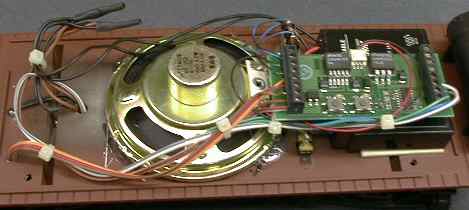toddalin: the print I posted is in the manual I received with each sound board. It shows pin 2 being a ground contact point for raising or lowering the volume on an external momentary contact switch. Pin 4 is a common ground for the lighting as also shown on Figure 10. The battery in that print is no where near that part of the circuit. Having never been on Greg's site I don't know where he got that from, do you?
EDIT: testing showed that below 14V of track power there was no indication across those two terminals, above 14V showed a constant 7V. Now that is voltage coming out of those terminals, don't know how that circuit would react having power applied in reverse. And how would that effect the volume and lighting circuits?
Take a meter and check for continuity between pin 2 and the - battery plug terminal, and pin 4 and the + battery plug terminal to confirm they are in fact the same. I remember doing this years ago, but didn't remember which pins. Greg's site discusses this and it is often easier to use the pins rather than dealing with the battery plug, which often breaks when the plug is removed.
As I said before, some regulators put out nothing until they see a certain voltage, but it seemed a bit lower (~12-13 volts).
The diode between the caps and Sierra in the latest sketch keeps the 7V produced by the Sierra board from feeding into the caps. The diode between the caps and buck/boost keep the caps from possibly backfeeding into the Buck/boost and taking this charge from the Sierra's idle time after shut-down. (BTW, we can still use the relay to conserve the voltage in the caps after shut-down.) I think that the Sierra will simply "see" which ever voltage is higher, so long as they are of the same polarity. It will not see the sum of the two voltages.
You can confirm this by running a train between two blocks on different dc power packs, where one block has a higher voltage, and when the train crosses blocks and sees both power packs simultaneously, it defers to the speed of the higher voltage, and not the sum of the voltages.
Again, Greg should be able to confirm this, or at least set us straight.







